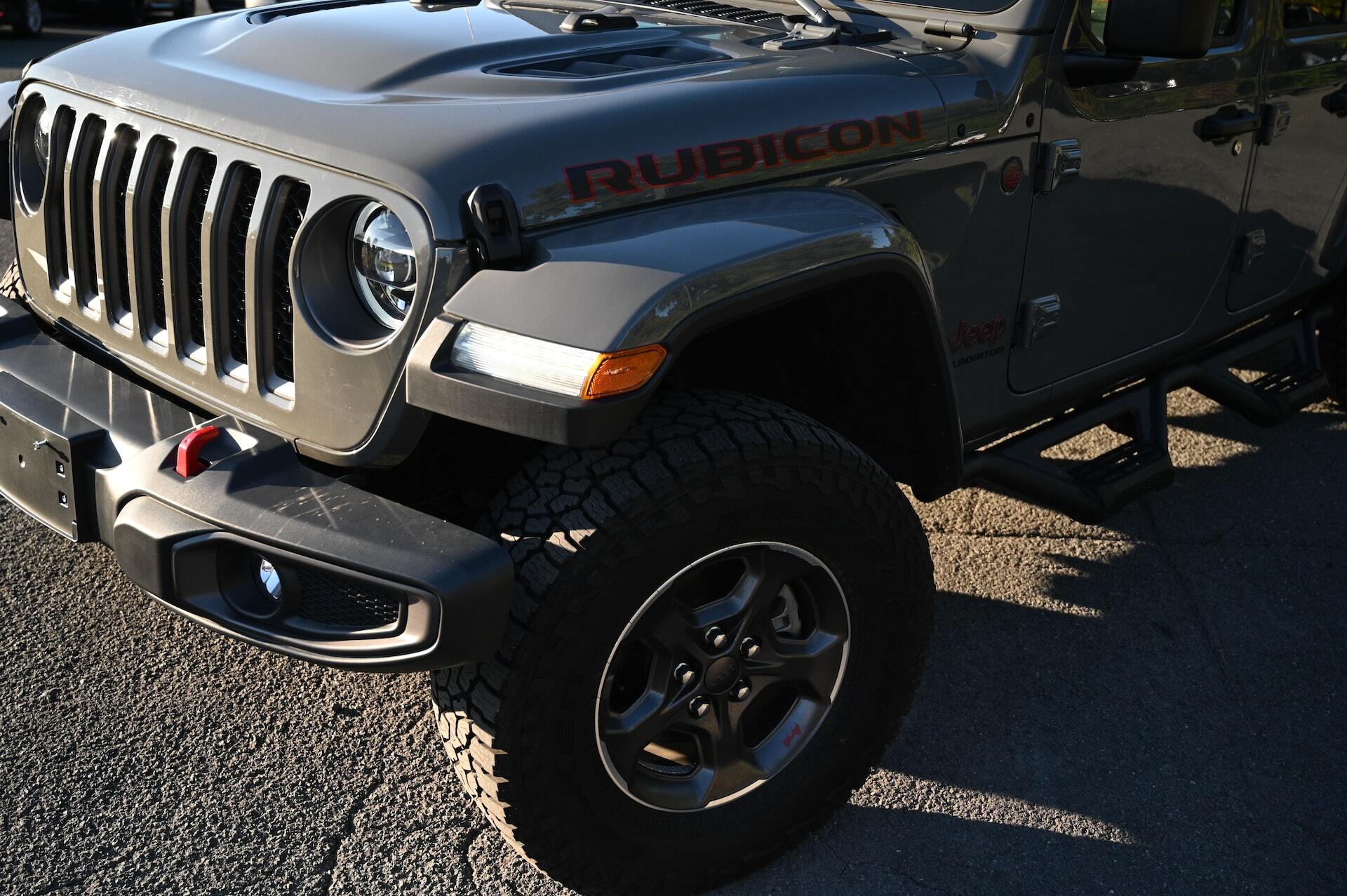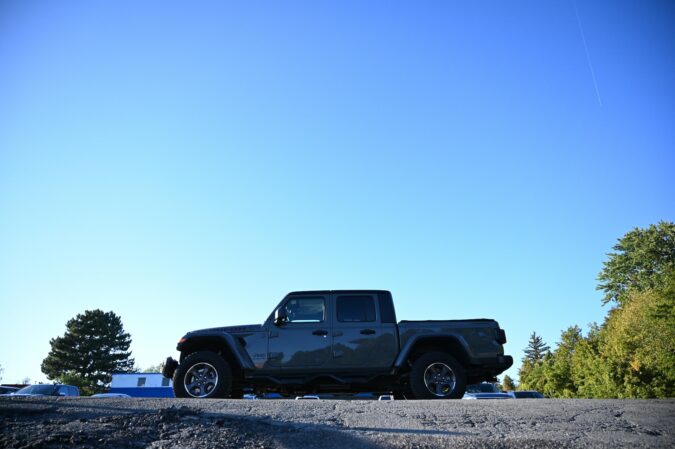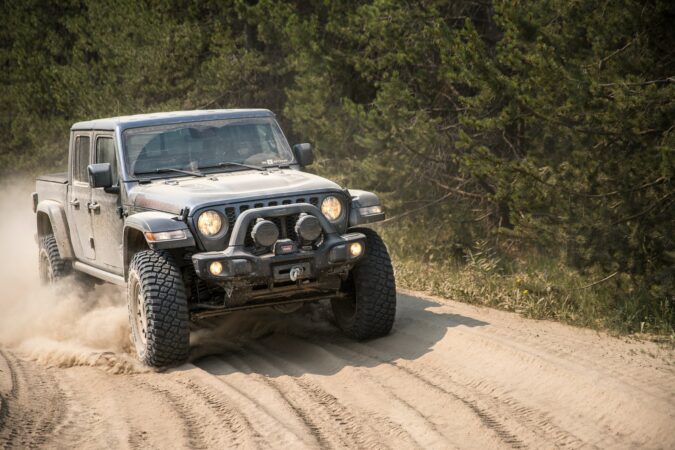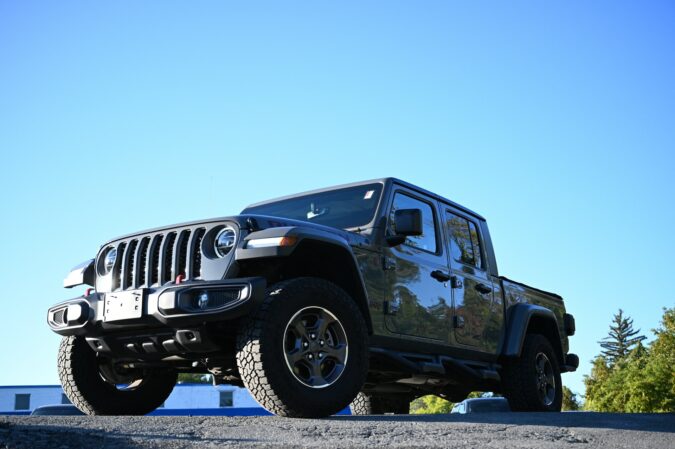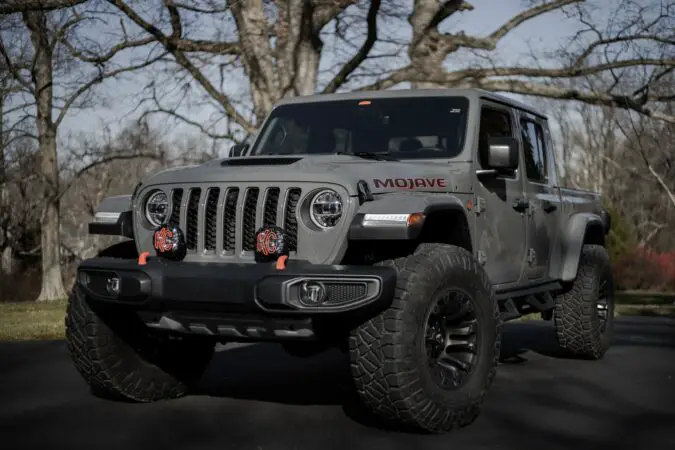One thing you probably know is that most wheels are universal. To put it another way, the Jeep Gladiator bolt pattern allows you to switch the wheels from your Gladiator to another vehicle and vice versa.
So, if you’re contemplating how much do black rims cost, want to dip rims in chrome, or want to get powder-coated rims, you can! However, not every rim can be attached to your Gladiator studs with a bolt-on. Several crucial elements should be taken into account if you want to be certain of fitment.
The most important thing you should do is compare the bolt pattern. This means comparing the Jeep Gladiator bolt pattern to the bolt pattern on the wheel you wish to purchase.
For you to get the best solution, you will often need to understand the bolt pattern information. To obtain information on the bolt pattern, select the year, make, and model of your car.
You get the diameter of a wheel bolt by the center of the wheel lugs or bolt holes. Occasionally, you’ll hear folks use the terms “bolt circle,” “lug pattern,” or “lug circle.”
But there are also a few alternative names. Keep in mind that a wheel bolt with dimensions of 5 by 4.5 refers to a 5-bolt pattern. This has a 4.5-inch diameter.
Lug Nut Torque
The word “torque” may have come up when you mounted your wheels.
But what precisely is torque and how does it operate?
Let’s investigate!
Jeep Gladiator Bolt Pattern, Tips #1 – What Precisely Is Wheel Torque In A Car
The lug nuts’ tightness determines the torque of a car wheel. Foot pounds are a unit of measurement for this degree of tightness.
The number of pounds needed to move an object a specific distance is expressed in terms of foot-pounds.
It can be adjusted to a tightness of up to 90 pounds. Or you could go as low as 30 pounds, depending on the lug nut tightness of your car.
Jeep Gladiator Bolt Pattern, Tips #2 – Is It Essential To Tighten Lug Nuts In A Particular Order
The distribution of wheel lug nuts is uniform, which keeps the tires balanced.
Unbalanced tires aren’t ideal for your car’s performance, driveability, or efficient commute. Otherwise, you’ll have to consider the cost of a tire balancing job.
It makes sure that each component of the tire is able to withstand the same amount of pressure.
Let’s consider uneven stress distribution and wear on particular areas of the tire. This might result from improper lug nut tightening techniques or patterns.
If not, you might notice issues such as the outside of your front tires wearing, or seeking to find what causes tire wear on the inside. The latter is also known as inside tire wear or inner tire wear.
Jeep Gladiator Bolt Pattern, Tips #3 – Considerations And Calibrations For Torque Wrenches
When using a torque wrench (and understanding how to use torque wrench), there are a number of things to keep in mind.
For instance, you must ensure that the wrench is correctly calibrated. This is because this will have an impact on the precision of the measurements.
If the calibration is inaccurate, a professional recalibration is required.
Before applying any torque, it’s also crucial to inspect the state of your lug nuts. Also, inspect other components because they can be worn out or broken and need to be replaced.
Additionally, it’s crucial to tighten your wheel lugs with the proper amount of force to avoid over or under-tightening them.
Finally, it’s critical to be aware of any changes in environmental factors. These include changes in humidity or temperature. This is because these may affect how much power is needed to achieve the right torque settings.
Jeep Gladiator Bolt Pattern, Tips #4 – How Tightly Should Car Wheel Nuts Be Torqued
The recommended torque for car wheel nuts is specified in the vehicle handbook. Auto repair manuals are handy to have by your side for references.
The majority of car wheel nuts should, however, be torqued. Ensure a range between 80 and 110-foot pounds as a general guideline.
Foot-pounds are a unit of measurement used to torque lug nuts. The size of the lug nuts affects the torque you apply.
7/16-inch lug nuts need to be torqued between 70 and 80-foot lbs.
9/16 inch requires 135 to 145 torque pounds, compared to 1/2 inch’s 75 to 85 torque pounds.
You can obtain the ideal torque with the use of a torque stick or torque wrench.
It’s crucial to avoid overtightening the wheel nuts because doing so could harm the wheel or the nuts’ threads.
Under tightening the wheel nuts increases the risk of the wheels coming off while you’re driving, which is dangerous.
Jeep Gladiator Bolt Pattern, Tips #5 – How Can I Get My Wheels The Proper Amount Of Torque
Make sure the lugs are grease and oil-free before tightening them.
The owner’s manual is the finest source of information for determining the proper torque for your car’s wheels.
Every car type has unique requirements. It’s crucial to follow them. This is in order to retain the best performance and safety.
Take your car to a qualified mechanic who can assist you make the necessary adjustments. This is if you have any questions about how to use a torque wrench or other tools effectively.
Jeep Gladiator Bolt Pattern, Tips #6 – How To Determine How Much Torque My Wheels Require
The size, material, and weight of the tires, as well as other variables, will all have an impact on how much torque is necessary to turn the wheels of your car.
To find the best setting for your specific automobile model, it’s vital to speak with a qualified mechanic or an experienced driver.
You should be able to get the best performance out of your car with the right upkeep, all while keeping yourself and other road users safe.
Jeep Gladiator Bolt Pattern, Tips #7 – Can I Overtighten My Wheel Nuts
It is easy to overtighten the wheel nuts on your car. This may result in damage to the wheel or the nuts’ threads, as well as make subsequent nut removal challenging.
It’s crucial to closely adhere to the torque recommendations provided by the manufacturer to prevent overtightening your wheel nuts.
Additionally, it is a good idea to routinely check the torque on your wheel nuts, particularly if you are traveling through terrain that may cause more vibration or stress.
Jeep Gladiator Bolt Pattern, Tips #8 – How Often Should New Wheels Be Torqued
As the wheels adapt to the car, torque is crucial when installing new wheels.
As a general rule, torque your new wheels 50 or 100 miles into their use.
It is a good idea to check the torque more regularly if you are driving in challenging circumstances, like on gravel roads or in torrential rain.
Jeep Gladiator Bolt Pattern, Tips #9 – What Occurs If I Tighten Lug Nuts Too Much
Wheel studs stretch due to over-tightening. These are the metal bolts or posts where you will fasten the wheels.
This strain could possibly cause the stud to break. Tire damage could result from this fracture. Furthermore, it might strip the bolts. Even the possibility of braking rotor warpage exists.
Jeep Gladiator Bolt Pattern, Tips #10 – Can Excessive Torque Harm The Brakes
Too much torque may harm the brake rotors. The entire brake system could damage due to the vehicle’s shaking.
Furthermore, the vibration brought on by an overtightened tire may loosen or possibly harm other components of the car.
This increases the risk of car accidents on the road by affecting how well your vehicle can steer and brake. To minimize these hazards, it is crucial to ensure that your wheels have sufficient torque.
Jeep Gladiator Bolt Pattern, Tips #11 – What Occurs When A Car Lacks Insufficient Torque
There could be a negative impact on a car’s performance on the road if it has insufficient torque. The wheels’ balance and functionality will be impacted.
They could wobble, which would be problematic for the whole vehicle. Such scenarios could include noticing how the steering wheel shakes at low speeds, or how the steering wheel shakes when braking downhill.
Similar situations include the infamous Ford death wobble. Therefore, the wrong torque on your lug nuts might be what causes the Jeep death wobble.
It’s possible that the car can’t brake or accelerate well, which can cause collisions or other mishaps.
Additionally, improper torque can lead to the deterioration of automotive components like brakes and wheels over time, thereby raising repair expenses.
Jeep Gladiator Bolt Pattern, Tips #12 – Can I Fasten My Wheel Nuts Using An Impact Wrench
It is not a good idea to use an impact wrench to tighten the wheel nuts on your car. The nuts’ threads may be entirely stripped or damaged as a result.
When tightening wheel nuts, it is essential to use a torque wrench or a torque stick since this will enable you to reach the proper amount of torque.
Jeep Gladiator Bolt Pattern, Tips #13 – How Frequently Should The Wheel Nut Torque Be Checked
The amount of time you spend driving and the normal types of road conditions you face will determine how frequently you should check the wheel nut torque.
When changing your tires or performing other routine maintenance on your car, or at least once a year, several experts advise monitoring the torque.
Bring your car in for a checkup as soon as you see any indications of damage to your wheels or wheel nuts, such as excessive wear or vibration while driving.
You can assist ensure optimal performance from your vehicle and maintain your own safety on the road by giving it routine care and attention.
Jeep Gladiator Bolt Pattern, Tips #14 – Do Mechanics Always Check The Torque Of The Wheel Nut
Yes, when servicing a car, mechanics should always check the wheel nut torque.
This is so that the wheels can operate correctly and safely, which requires the proper amount of torque.
If the nuts are not properly torqued, it could cause issues including difficulty steering, more tire wear, and overall lower performance.
Driving with wheel nuts that don’t have the righting torque can occasionally be even more dangerous.
Granted, too much torque can also be a bad thing, as over-tightening them will often require you to use stripped lug nut remover tools to loosen them down the line.
Jeep Gladiator Bolt Pattern, Tips #15 – How Are Wheel Nuts Tested For Torque
You can measure the torque of a car’s wheel nuts using a variety of different equipment.
https://www.youtube.com/watch?v=I0huARZDB3w
These could include specialized tools or digital torque gauges that either directly connect to the nuts themselves or to the computer system of the vehicle.
The precise procedure for you to follow will depend on the make, model, and type of wheels and other components that your car has.
However, the majority of mechanics will first gently loosen each nut before checking it with a torque wrench or gauge to ascertain what setting is necessary.
Before you can get an exact reading, you might need to make adjustments multiple times.
The mechanic will next tighten each nut one more in accordance with the required torque after completing this successfully.
It is significant to remember that when it comes to checking wheel nut torque, not every mechanic will have the same tools or training.
Jeep Gladiator Bolt Pattern, Tips #16 – Why Is Using The Proper Torque Crucial
The proper torque is crucial for the effective operation of your car’s wheels. It makes certain that the wheels fasten securely to your vehicle, enabling you to accelerate, steer, and halt safely.
It has an impact on how your car steers, handles, and brakes, and can even have an impact on how safe it is.
Your car’s tires could malfunction or possibly sustain damage if not given the required amount of torque.
For this reason, it’s imperative to always ensure that the torque settings on your wheel nuts are accurate.
Your automobile might not run as well or be as safe on the road if there is no proper torquing of the wheels.
Jeep Gladiator Bolt Pattern
Since 2020, the Jeep Gladiator bolt pattern is 5137 mm, also known as 55.5 in. What does this entail for you, though?
Continue reading to learn more about the Jeep Gladiator bolt pattern, how to identify yours on any automobile or truck, and what they imply.
You should always measure your Jeep Gladiator bolt pattern to double-check it.
- 2022 5×137 mm (5.5 in)
- 2021 5×137 mm (5.5 in)
- 2020 5×137 mm (5.5 in)
1. What Is A Bolt Pattern
The bolt pattern is the positioning and alignment of the bolts on a wheel. It refers to the quantity and spacing of bolts needed to secure the rim of the car. You can also refer to them as the lug pattern.
Without an adaptor, there can be no altering of the bolt patterns. A car’s normal bolt pattern is provided with the car.
You can get the number of bolts by the first number in a bolt pattern. Typically, this number is 4, 5, 6, or 8.
You can get the diameter of the lug circle by the second digit in a bolt pattern.
And while you’re here, you could also refer to our tire size chart, as well as our guides on how to read the rim size, if you need some help.
2. Where Do I Measure Bolt Pattern
Count the number of lugs on the wheel, and measure the diameter to determine the Jeep Gladiator bolt pattern.
You can use both inches and millimeters to measure and present this dimension.
You can use an imaginary circle that passes around the centers of all the bolts to calculate the diameter.
You can calculate the diameter from one bolt’s center to another’s center across it. However, you can get the diameter of an odd bolt pattern by drawing a circle across the center of all the bolts.
3. Why Is Bolt Pattern Important
To choose the right rims for your car, you must be aware of the bolt pattern of your car or truck. But before you buy a new set of wheels, make sure you’re aware of how much are car rims.
The bolts secure the rim, and consequently the wheel and tire, to your vehicle. The bolts on the rim and the car must line up in order to install it.
You may use the adaptor to alter the Jeep Gladiator bolt pattern that is, if the accurate bolt pattern that is on the rim does not match the pattern that is on your vehicle.
But these adapters also serve as spacers for the rims. This will cause a much wider wheel track since the wheels on your truck would protrude further out the side of the car.
Typically, this is solely for aesthetic purposes. You shouldn’t intend to tow or haul anything with the automobile if you’re utilizing an adaptor.
They typically cannot withstand the intense impact and power needed to carry big weights, which tends to reduce the truck’s capacity.
You will need to hunt for adapters/spacers that can change the bolt pattern if you want to use a different type of bolt pattern.
Bolt Pattern Guide
You desire fresh tires. We need new tires. But do the desired wheels actually suit your car? The first thing to take into account is the bolt pattern on your wheels.
If you can’t bolt the wheels onto your 44, it doesn’t matter if they have the exact backspacing and diameter to match your tires.
You can find the Jeep Gladiator bolt pattern by the number of lug studs and the bolt circle, such as 55.5 or 8170. The distance of the bolt circle is often in millimeters (170) and inches (5.5).
The math is simple if there are an equal number of lug studs; just measure from one stud’s center to the one right across from it.
The arithmetic becomes challenging if there are an odd number of lug studs because you must measure from each stud to an imaginary line that connects the two studs that are opposite each other.
Since five-lug wheels come in a range of bolt circles, including 54.5, 55, and 55.5, this becomes very challenging. It can be difficult to distinguish them just by looking at the bolt circle.
Bolt Patterns: What They Tell Us
From the tiny 4100 Geo Metro bolt pattern to the enormous 8180 patterns on current GM trucks, there are many different types of bolt patterns.
More lug nuts increase the clamping force needed to secure the wheel to the car.
Consider the fact that you can distinguish between a half-ton and a one-ton truck (for more details, check out our detailed write-up of the 1/2 ton truck towing capacity) with ease since the former will have five or six studs, but the latter will have eight.
Furthermore, using a bigger hub and bearings is possible because of the greater load distribution provided by the larger bolt circle.
Rim Studs
Now that it is clear that having more lug studs and a wider pattern are better, what about the lug nuts themselves? The following are the fundamental aspects of wheel fasteners:
A 1/220 size has a 1/2-inch diameter and 20 threads per inch in SAE sizing.
A 141.5 has a 14mm diameter and 1.5mm of space between the threads in metric sizing.
Thus, a higher thread pitch number indicates a finer thread when using SAE sizing, but a coarser thread pitch when using metric sizing.
One method to improve the strength and gripping force of the connection between your axles and your wheels is to install larger studs.
However, the holes in your wheel must be sufficiently large to fit the larger studs.
Lug Nuts
Although lug nuts appear to be quite straightforward, there is much more variation in them than just the lug nut size. It is imperative that you use the correct lug nuts for your individual wheels.
The contour of the lug nut’s base, which makes contact with the wheel, is the “seat.” Despite some radius seats, conical seats are the most typical for aftermarket wheels.
Flat seats are frequently a feature on factory-supplied wheels and occasionally on aftermarket wheels as well.
Conical seats are the most popular since they depend less on the hub register and lug stud size, making a wheel suitable for more applications.
Lug Centric Or Hub Centric
Wheels must be dead center on the axle hub using the lugs or the hub in order to run straight. Hub Centric wheels are those that register via the center bore.
Compared to aftermarket wheels made to accommodate a variety of applications, OEM wheels tend to have more of these wheels.
In the aftermarket, lug-centric wheels—which employ the studs to center the wheel—are much more prevalent.
To get the greatest fitment with lug-centric wheels, the size of the lug holes in the wheel should nearly match the lug size on the vehicle.
If you’re interested in learning more about lug patterns, we’ve covered this with other vehicles, too. So, for a bit more insight, check out our resources on the lug pattern for the Ford F150, and the bolt pattern for a Ford Fusion, as well as the bolt pattern for a Chevy Silverado.
Frequently Asked Questions
What Is A Bolt Pattern
The number and spacing of the lug hole apertures that correlate to the appropriate stud or bolt pattern measurement on the vehicle hub make up the bolt pattern.
What Is 5×4 5 Bolt Pattern
You will be between bolts if your car has five lugs; simply choose one of the nearest bolts and take a measurement to the center. Your car has a 5×4 bolt pattern if you count five bolts and the distance between the opposite bolts is 4.5 inches.
What Vehicles Have A 5×5 Bolt Pattern
Classic Buick, Pontiac, and Oldsmobile are part of this. Therefore, you probably have a 5×5 bolt pattern if you’re utilizing a large Old’s rear end. Following the phase-out of the six-lug bolt pattern, Chevrolet and GMC began adopting this bolt pattern for its light two-wheel drive trucks in 1971.

